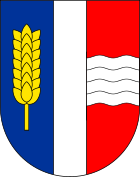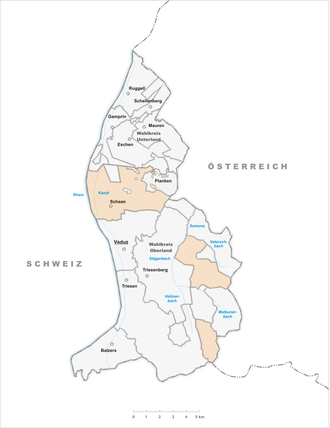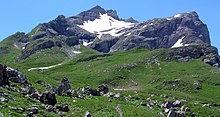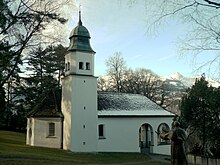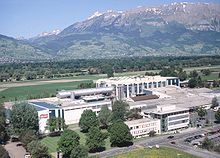Schaan
| Schaan | |
|---|---|
| banner | coat of arms |
| Country: |
|
| Constituency : | Oberland |
| Municipality number : | 7005 |
| License plate : | FL |
| Postal code : | 9494 |
| UN / LOCODE : | LI SCN |
| Coordinates : | 757 114 / 226 196 |
| Height: | 462 m above sea level M. |
| Surface: | 26.920 km² |
| Residents: | 5998 (June 30, 2019) |
| Population density : | 223 inhabitants per km² |
| Proportion of foreigners : | 38.1% (June 30, 2017) |
| Website: | www.schaan.li |
| Location map of Schaan in the Principality of Liechtenstein | |
Schaan is a municipality in the Oberland of the Principality of Liechtenstein . Schaan has four enclaves - it is thus a five-part municipality - as well as two enclaves , each belonging to Vaduz and Planken . With 6,007 inhabitants (June 30, 2018) it is the most populous municipality in the Principality and represents an important traffic junction and industrial location in the country. The name Schaa is pronounced in the Liechtenstein dialect .
geography
|
Schaan, the northernmost municipality of Liechtenstein Oberland . The two old parts of the village at the chapel of St. Peter and in the Parish Church of St. Lawrence (St. Lawrence) is located on a leaking to the west of the Rhine Rift Rüfeschutthügel the Three Sisters massif . Schaan borders in the south on the main town Vaduz , in the east on Planken and Triesenberg , and in the north on the communities Eschen and Gamprin . In the west the Rhine forms the natural border with Switzerland, in the east the place is dominated by the mountain range Drei Schwestern.
Schaan owns four exclaves. Brunnenegg and the Plankner Neugrütt are two steep wooded parcels on Oberplanken and east over Planken. The two exclaves Gritsch and Guschg / Vorder- / Mittler valorsch are used for alpine farming. The Wes enclave belongs to the municipality of Planken, the Forst enclave to Vaduz.
Alps
The Alp Gritsch located in the southern Saminataltal east above the Triesner Alp Valüna . Gritsch is the highest alp in Liechtenstein and extends to the Naafkopf at 2570 m above sea level. M . It was probably acquired by the Schaan-Vaduz parish in the 14th century . A letter of arbitration from 1503 divided the use of the Gritsch and Guschg Alps between the two Schaan village parts. Gritsch was assigned to the St. Lorenz part of the village, Guschg to the St. Peter part of the village.
In 1935 the Pfälzerhütte was built in the area of Alp Gritsch . In 1940 one found on Gritsch one in the 3rd or 2nd century BC. Lance tip manufactured in BC. The Gritsch and Guschg cooperatives in Schaan owned their own dairy until the 20th century . Since 1960 only Galtvieh have been summered on Gritsch.
The Kuhalp Guschg is located at the eastern foot of the Schönberg and originally belonged to the parish of Frastanz . In 1361 the parish of Schaan-Vaduz acquired the alp from several owners who u. a. came from Frastanz, Planken and Rankweil . The alp was probably used by the residents of the Dorteil St. Peter before 1503.
In 1922 the Guschg Alpine Cooperative bought a hunting lodge on Sass from Prince Franz Josef II . Together with Alp Guschg, it belongs to the Sass high hunting area, which is leased to private individuals.
Valorsch borders on Guschg with the Alps of Vorder, Mittel and Hintervalorsch. Because of a dispute between Vaduz and Schaan, Hintervalorsch was separated in 1643. Since then, the fore and middle valorsch have belonged to Schaan, and the rear valorsch to Vaduz.
→ Main article: Valorsch
| Alp | origin of the name | Owner | Total area | productive pasture area | Alpine building | source |
|---|---|---|---|---|---|---|
| Gritsch | alt rät.rom. alp grialits ( ram alp) (?) | Alpgenossenschaft Gritsch | 341.6 ha | 106 ha | 1897 m above sea level M. | |
| Guschg | from rät.rom. cusch (a) (tree trunk) (?), derived clearing name | Guschg Alpine Cooperative | 449.8 ha | 132 ha | Guschg: 1713 m above sea level M Sass: 1646 m above sea level M Stachler: 1440 m above sea level M. |
|
| Vordervalorsch | rät.rom. val uors (Bärental) | 135.5 ha | 28 ha | 1371 m above sea level M. | ||
| Medium Valeorsch | Alpgenossenschaft Gritsch | 175 ha | 44 ha | Under Hötta: 1380 m above sea level. M. Ober Hötta: 1579 m above sea level. M. |
history
Archaeological finds have shown that Schaan has been inhabited for over 6000 years:
In the year 15 BC The Romans under Augustus conquered the territory of today's Principality of Liechtenstein and established the Roman province of Raetia . In the 1st century AD, the military road Milan – Bregenz was built, which ran over the Luzisteig along the right bank of the Rhine, so that Roman buildings were also built in Schaan. Also from the 1st century AD come two Roman legionnaires' helmets, which were found during grave work above Dux in 1887 and were probably buried here as consecration offerings of the two Roman legionaries Publius Cavidius Felix and Numerius Pomponius, whose names are carved on the helmets . Today they are in the museums of Bregenz and Zurich. The most important Roman building on the parish soil is a fort in the valley floor , which was built to protect against the increasingly frequent Alemannic incursions. Remains of his foundation walls and the gate tower are at St. Peter's Church visible again ( 756 969 / 225,689 ). A baptistery from the 5th century, which was found during excavations inside this church, suggests an early Christianization . Furthermore originated "On cripple" above Schaan, on the mountainside of the Three Sisters chain on a rocky promontory with a small plateau (60 x 30 meters) a fortified late Roman hilltop settlement ( 758.89 thousand / 225730 ). During excavations, older traces of settlement from prehistoric times were also found there.
Numerous grave finds document the Alemannic settlement. At that time, Schaan consisted of two separate parts: the Romanised Raetians had their center near St. Peter, while the Alemannic population settled in the Specki area. This dichotomy is evident to this day in the existence of two Alpine cooperatives, the northern Alemannic cooperative Gritsch and the southern Rhaeto-Romanic cooperative Guschg.
"Scana" was first mentioned in a document in the middle of the 9th century in a compilation of imperial goods. In 965, Schaan went to the Säckingen Abbey as a gift from Otto the Great in compensation for the abandonment of the island of Ufenau .
| year | 1584 | 1812 | 1901 | 1930 | 1945 | 1991 | 2000 | 2010 2 | 2017 3 |
| Residents | 393 | 715 | 917 | 1,464 | 2,048 | 5,035 | 5,454 | 5,799 | 6,039 |
coat of arms
|
|
The Schaan's coat of arms shows a blue field in front and a red field in the back, which are separated by a vertical silver (white) stripe. In the blue field a golden ear of wheat can be seen as a symbol for agriculture, in the red field a four-fold waved silver (white) stripe, which is supposed to symbolize the Rhine. The colors blue and red are the national colors of Liechtenstein. The coat of arms in this simplified form was awarded on November 26, 1948 by Prince Franz Joseph II and replaces the similar, but more differentiated coat of arms that was awarded by Prince Regent Franz Joseph on June 12, 1938.
Infrastructure
traffic
Liechtenstein itself does not have any motorways, but the Swiss A13 runs along the left bank of the Rhine. With the motorway exit in the St. Gallen municipality of Buchs, Schaan has a motorway connection in the immediate vicinity.
In Schaan, the Schaan-Vaduz train station is located on the Feldkirch – Buchs line operated by the Austrian Federal Railways , which is also used by the Montafonerbahn .
The S-Bahn FL.A.CH project was intended to expand the range of regional transport services on the Feldkirch – Buchs line. An important goal was u. a. to get commuters from Austria to Liechtenstein to change to the train. It was planned to run every half hour during rush hour. However, this would have required a dual track expansion in the Tisis - Nendeln area . In 2015 the government stopped the FL.A.CH S-Bahn project due to discrepancies in funding.
Schaan is the most important hub in the Principality of Liechtenstein for public bus transport operated by the LIECHTENSTEINmobil transport company .
education
- The Schaan community schools consist of seven basic levels (kindergarten level 1 & 2 and 1st grade) at five locations, which are taught in a mixed-age system, as well as four grade levels, which are run in either two or three classes. A day school has also been run since the 2008/2009 school year.
- Secondary schools in Schaan are the Schaan Realschule and - at the same location - the Liechtenstein Sports School.
- The Mühleholz school center is already on the Vaduz area, but practically on the municipal boundary, which houses both the Vaduz secondary school and the Vaduz high school (Mühleholz school center 2) as well as the Liechtenstein grammar school (Mühleholz school center 1).
- Another school offering is the Liechtenstein Waldorf School , which has existed since 1985; Here children from kindergarten to 9th grade experience upbringing and education according to the principles of Rudolf Steiner . The students come from Liechtenstein and the neighboring countries of Austria and Switzerland.
- The day school at the Heilpädagogisches Zentrum (HPZ) is set up for children who have special needs due to their development.
- The Stein Egerta Anstalt is Schaan's institution for adult education. A wide range of educational and advanced training opportunities is offered in around 700 courses a year. The in-house training institute of the Liechtenstein Chamber of Commerce (WKL) also conducts professional training events and courses.
Culture and sights
- The parish church of St. Laurentius was consecrated in 1893. The church tower reaches a height of 81 meters and has had a total of six church bells since 1968. Around half of the church was financed by the then Prince Johann II , in whose honor a memorial was erected on the west side of the church. Between 2003 and 2005 the church was extensively renovated.
- Roman fort : In the 1st century AD, the military road Milan-Bregenz was laid out, which also led through today's municipality of Schaan. A witness of this is a Roman fort built in the 4th century, which was built to secure the borders of the Roman Empire. The fort had a square floor plan with a side length of around 60 meters and, in addition to four corner towers, had a central tower on the south side and a gate tower in the north. Parts of the foundation walls and remains of the gate tower are still preserved today.
- Church of St. Peter : Based on the excavations in 1958, two previous buildings can be described: A hall church with an attached baptistery . This building was probably built immediately after the fort was abandoned, using some of the fort's walls. A burial site was also excavated in the baptistery. In the 9th / 10th In the 19th century the church hall was enlarged by reducing the size of the baptistery and a sacristy was added south of the choir. The church was first mentioned in 1298. Today's church is of late Gothic origin and used to be the parish church of the community.
- The Chapel of St. Mary of Consolation on Dux ( Dux Chapel) with a baroque altar of Mary was built on the foundations of an earlier chapel in 1716. Later it was supplemented with a tower and vestibule and fundamentally restored in 1997/1998.
- The St. Elisabeth monastery was built in 1934/1935. From 1942 to 1946 the sister monastery ran a girls' high school and from 1946 to 1976 a secondary school for girls. A secondary school has been located in the monastery premises since 1976.
- The building history of the old parish church of St. Laurentius has not yet been clarified. The tower, which is the only part of the building still standing today, was probably built in the 12th century. In 1900, after the inauguration of the new parish church, the church was demolished except for the tower.
- The St. Johannes cemetery chapel is a funeral hall on the Schaan cemetery, which was built in 1934 according to plans by the architect Erwin Hinderer. There is also a memorial plaque for the fallen and missing of the First World War.
- The town hall of the municipality of Schaan is located in a former school. The building was erected between 1844 and 1846 and served as a school building until 1975. Since then, the municipal administration and the municipal museum have been housed in the building. The gym extension was used as the town hall hall for many years, with the creation of the SAL (see below) it was integrated into it as a small hall .
- The TAK Theater Liechtenstein (TAK or formerly TaK stands for Theater am Kirchplatz , the previous name of the theater) offers a wide range of cultural events: drama, concert, ballet, dance theater, pantomime, jazz, chanson, cabaret, puppet shows, children's and youth theater
- The village museum (domus) is a museum and a gallery of the municipality of Schaan in the town hall, which shows artistic works from the region and the history of Schaan in changing exhibitions.
- The hall at Lindaplatz (SAL) was opened in 2010 and offers around 2,200 square meters of space for various events. On the one hand, events are organized by the community itself; on the other hand, it can be hired by third parties for their own events.
economy
With over 9,000 jobs in around 875 companies, Schaan is an important business location for the entire region. In Schaan u. a. the Hilti AG , the Hilcona AG and Ivoclar Vivadent AG headquartered. In addition, the largest beer brewery in the Principality of Liechtenstein (Liechtensteiner Brauhaus) can be found in Schaan. The distribution center and the headquarters of Liechtensteinische Post AG are also located in Schaan.
Schaan is also the seat of the Liechtenstein Chamber of Commerce and the location of the Liechtenstein Industry, Trade and Trade Exhibition (LIHGA).
politics
Daniel Hilti ( VU ) has been the community leader of Schaan since 2003 . In the municipal election on March 15, 2015, he was confirmed in office with 83.2% of the valid votes. In 2019 he was re-elected with 84.4% of the valid votes.
The municipal council consists of twelve seats and has been composed as follows since the municipal elections on March 24, 2019:
- 5 MPs of the Progressive Citizens' Party (FBP)
- 5 MPs of the Patriotic Union (VU)
- 1 member of the Free List (FL)
- 1 member of the list The Independents (DU)
This means that the distribution of seats has not changed compared to 2015. The turnout was 71.4%.
Personalities
- Karl Wilhelm Schlegel (1828–1900), doctor and politician
- Tobias Jehle (1885–1978), building contractor and politician
- Adolf Buck (1896–1952), photographer
- Alexander Frick (1910–1991), politician
- Rosa Wachter (1911–1972), active in state welfare
- Adolf Schreiber (1913–1983), cyclist
- Toni Hilti (1914–2006), entrepreneur
- Gustav Kaufmann (1918–2015), marksman
- Alfred Hilbe (1928–2011), politician
- Gerta Keller (* 1945), geologist
- Gilbert Kaiser (* 1949), marksman
- Willi Frommelt (* 1952), ski racer
- Roman Hermann (* 1953), racing cyclist
- Paul Frommelt (* 1957), ski racer
- Sigmund Hermann (1959–2014), cyclist
- Doris Frick (* 1963), ambassador in Bern
- Peter Hermann (* 1963), cyclist
- Sabine Dünser (1977–2006), singer and musician
- David Hasler (* 1990), football player
literature
- Municipality of Schaan (ed.): Schaan Culture Trail. Tour in 21 stations . 2007.
- Hans Rudolf Sennhauser (Ed.): Early churches in the eastern Alpine region. From late antiquity to the Ottonian period. Bavarian Academy of Sciences. Treatises - New Series, Issue 123. Publishing House of the Bavarian Academy of Sciences, Munich 2003. ISBN 3-7696-0118-1 .
Web links
- Website of the municipality of Schaan
- Ulrike Mayr, Rupert Quaderer, Fabian Frommelt: Schaan. In: Historical Lexicon of the Principality of Liechtenstein .
- Arthur Brunhart: Schaan. In: Historical Lexicon of Switzerland .
- Schaan village (aerial photo / map)
Individual evidence
- ^ Tables of population statistics. (XLS; 345 kB ) June 30, 2019. Statistical Office (AS), Principality of Liechtenstein, accessed on December 24, 2019 .
- ↑ population statistics. ( PDF ; 913 kB ) June 30, 2017. Statistical Office (AS), Principality of Liechtenstein, p. 15 , accessed on January 31, 2018 .
- ↑ a b Hansjakob Falk: Gritsch. In: Historical Lexicon of the Principality of Liechtenstein . December 31, 2011 .
- ↑ a b Hansjakob Falk: Guschg. In: Historical Lexicon of the Principality of Liechtenstein . December 31, 2011 .
- ↑ a b Alois Ospelt: Valorsch (Alp). In: Historical Lexicon of the Principality of Liechtenstein . December 31, 2011 .
- ↑ Hans Jakob Falk: Spikes. In: Historical Lexicon of the Principality of Liechtenstein . December 31, 2011 .
- ↑ Georg Malin: The territory of Liechtenstein under Roman rule. 1958, p. 22.
- ↑ David Beck : The Schaan Castle (PDF; 11.4 MB) . In: Yearbook of the Historical Association for the Principality of Liechtenstein, 1957, Vol. 57 , pp. 229–272.
- ↑ David Beck: The prehistoric and late Roman settlement area "Auf Krüppel" above Schaan (PDF; 15.6 MB) . In: Yearbook of the Historical Association for the Principality of Liechtenstein, 1965, Vol. 64 , pp. 5–51.
- ↑ Population statistics June 30, 2010. Statistics Office (AS), Principality of Liechtenstein, p. 9, accessed on March 26, 2016 (PDF; 899 kB)
- ↑ Population statistics December 31, 2017. Statistical Office (AS), Principality of Liechtenstein, p. 14, accessed on January 2, 2020 (PDF)
- ^ Mathias Rellstab: Tri-national S-Bahn "FL.A.CH." on track. In: Swiss Railway Review . No. 1/2013. Minirex, ISSN 1022-7113 , p. 49
- ↑ Shipwreck for Liechtenstein S-Bahn project? In: Swiss Railway Review . No. 5/2015, p. 238
- ↑ / LIEmobil . Retrieved May 20, 2011.
- ^ Sennhauser (ed.) (2003). Pp. 172-173.
- ^ Parish of Schaan . Archdiocese of Vaduz. Retrieved May 20, 2011.
- ^ Website of the SAL Saal at Lindaplatz
- ↑ Employment statistics on December 31, 2014. Statistics Office (AS), Principality of Liechtenstein, p. 57, accessed on March 26, 2016 (PDF; 809 kB)
- ↑ Principality of Liechtenstein municipal elections 2019 - Schaan .
- ↑ Principality of Liechtenstein municipal elections 2019 - voting participation .
